- Share
Parental Assistance after Job Loss
We have previously shown that young adults who live near their parents experience faster earnings recoveries after a job loss than young adults who live farther from their parents. In this analysis, we present evidence that demonstrates the relationship is causal; that is, there is something about living close to one’s parents that enables one to find another job that pays as well as the one lost. We also explore what type of parental help might be driving the relationship and find that it is possibly the provision of childcare and access to job networks, but likely not help with housing expenses.
The views authors express in Economic Commentary are theirs and not necessarily those of the Federal Reserve Bank of Cleveland or the Board of Governors of the Federal Reserve System. The series editor is Tasia Hane. This paper and its data are subject to revision; please visit clevelandfed.org for updates.
Job displacement—where an employee loses a relatively stable job through no fault of their own, as in a layoff—is perhaps more common than most people realize and more detrimental. Almost half of all workers experience a job displacement at some point during their career, and the impact on their future earnings can be significant. It has been documented that displaced workers experience large and long-lasting earnings losses, around 10 percent to 20 percent, on average, even 20 years after the displacement event (Jacobson, LaLonde, and Sullivan 1993).1 Because of the prevalence and negative consequences of such an event, it is important to understand how the scarring effects of job displacement can be ameliorated.
In a previous Commentary (Coate, Krolikowski, and Zabek, 2017b), we documented that young adults who live near their parents experience stronger earnings recoveries after a job displacement than those who live farther away.2 In fact, on average those living near their parents experience a full recovery in earnings within 10 years of the displacement. In this analysis we present evidence that suggests this finding is more than a correlation and that there is actually a causal link between living near one’s parents and faster earnings recoveries after a job displacement event.
We also present some evidence on what might drive this causal relationship and rule out some possible explanations. We find that the positive earnings effect is concentrated among workers who have children of their own, a situation which suggests that the parents’ help in caring for the grandchildren is important in achieving the healthier earnings recovery. We also find some weak evidence that young adults who live closer to their parents are more likely to be employed in their parents’ industries after a job displacement, suggesting that parents might help their children by finding jobs for them, perhaps through employment networks. We find that housing provided for or subsidized by parents is an unlikely explanation for our findings, although there is evidence that young adults, as a whole, move back in with parents after economic turbulence.3
Box 1. Data Recap
- Panel Study of Income Dynamics (PSID)
- Annual data covering 1968 to 2013
- Earnings information for household heads between the ages of 18 and 62
- Displaced workers are defined as those who
- lost relatively stable jobs through no fault of their own (e.g., plant closings)
- were with their employer for at least two years and were working full time before the job displacement event
- Sample includes around 20,000 young workers, aged 25–35, with an average of 20 years of observations for each
- 700 job displacement events
- approximately 200 while an individual resided in parents’ neighborhood
- approximately 500 while an individual was not in parents’ neighborhood
- Data include repeated observations of individuals’
- demographic information
- labor earnings in the previous calendar year
- job histories
- parental location
For more detail and summary statistics, see Coate, Krolikowski, and Zabek (2017a).
Parents Help Their Adult Children after Job Loss
As in our previous Commentary, we use annual data from the Panel Study of Income Dynamics (PSID) covering 1968 to 2013. We refer the reader to that Commentary for further details about how we construct the sample and summary statistics about the data. Here we simply note that the PSID is well-suited for our analysis because it contains detailed information about parents and their children, including labor earnings, job histories, geographic location, and a rich set of individual characteristics.
In our previous Commentary, we showed that raw averages seem to suggest that the earnings recovery after a job loss for those living in their parents’ neighborhood is much stronger than for those living farther away. This could be a result of numerous differences between individuals who are displaced and those who are not displaced and between those who live close to their parents and those who live farther away. In this Commentary, we control for these differences using a regression framework, which controls for characteristics of workers that do not change over time, including various unobserved characteristics such as motivation and some observed characteristics such as race, and a statistical technique called propensity score reweighting, which controls for a host of other observed characteristics of workers. In the present context, propensity score reweighting amounts to identifying individuals who are most similar to the individuals living in their parents’ neighborhoods and who experience a job displacement. We compare individuals along several observed dimensions, including predisplacement earnings, wages, occupation, the industry in which they work, education, tenure, local labor market conditions in the place of residence, and demographic characteristics.
Figure 1 plots the average earnings before and after displacement for those who were in their parents’ neighborhoods in the year prior to displacement (red) and those who were not (blue) after we have applied the propensity score technique. There are two things to note about this figure. First, the propensity score reweighting does a nice job identifying individuals who are observationally similar: Prior to the displacement event, all four groups of workers have similar earnings levels and trends, and after the displacement event, the two nondisplaced groups (same tract and different tract) have similar earnings trajectories. This suggests that the reweighting has succeeded in finding individuals who are most similar to displaced individuals living in their parents’ neighborhoods from among those who live farther away from their parents and those who live near their parents but are not displaced. Second, the qualitative results are the same as in our previous Commentary: Displaced workers not in the same neighborhoods as their parents (dashed blue) see large earnings losses relative to the losses of those who were not displaced (solid blue). This earnings gap persists over the following 10 years. In contrast, displaced workers who were in the same neighborhoods as their parents in the year prior to the displacement event see a much healthier earnings recovery (dashed red), surpassing the control group (solid red) six years after the displacement event.
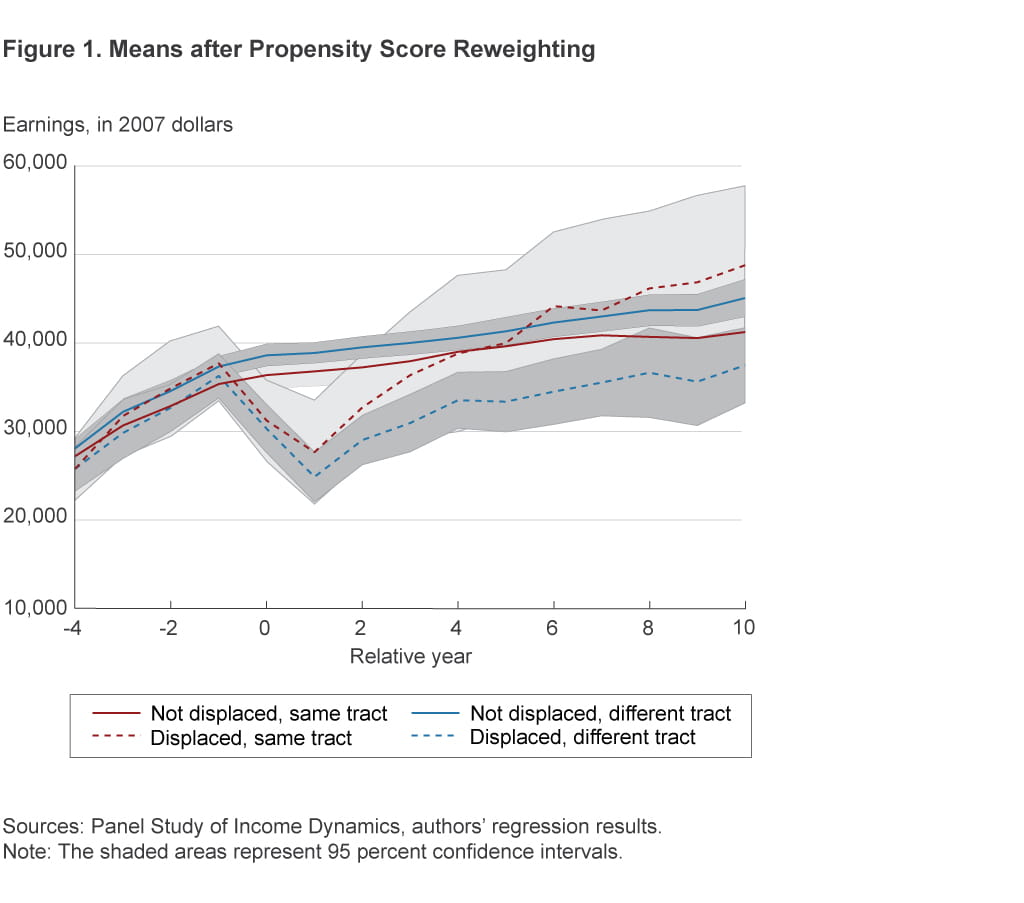
Figure 2 presents the same results but from a regression framework wherein we control for differences between individuals that do not change over time, including some observed characteristics and, using individual fixed effects, unobserved characteristics. The results tell the same story as figure 1. At the time of displacement, individuals living in their parents’ neighborhoods (dashed) and those living farther away (solid) experience similar declines in earnings, around $10,000 (2007 dollars). After the displacement event, however, individuals living in their parents’ neighborhoods experience a robust recovery in earnings, whereas those living farther away see only modest improvements.
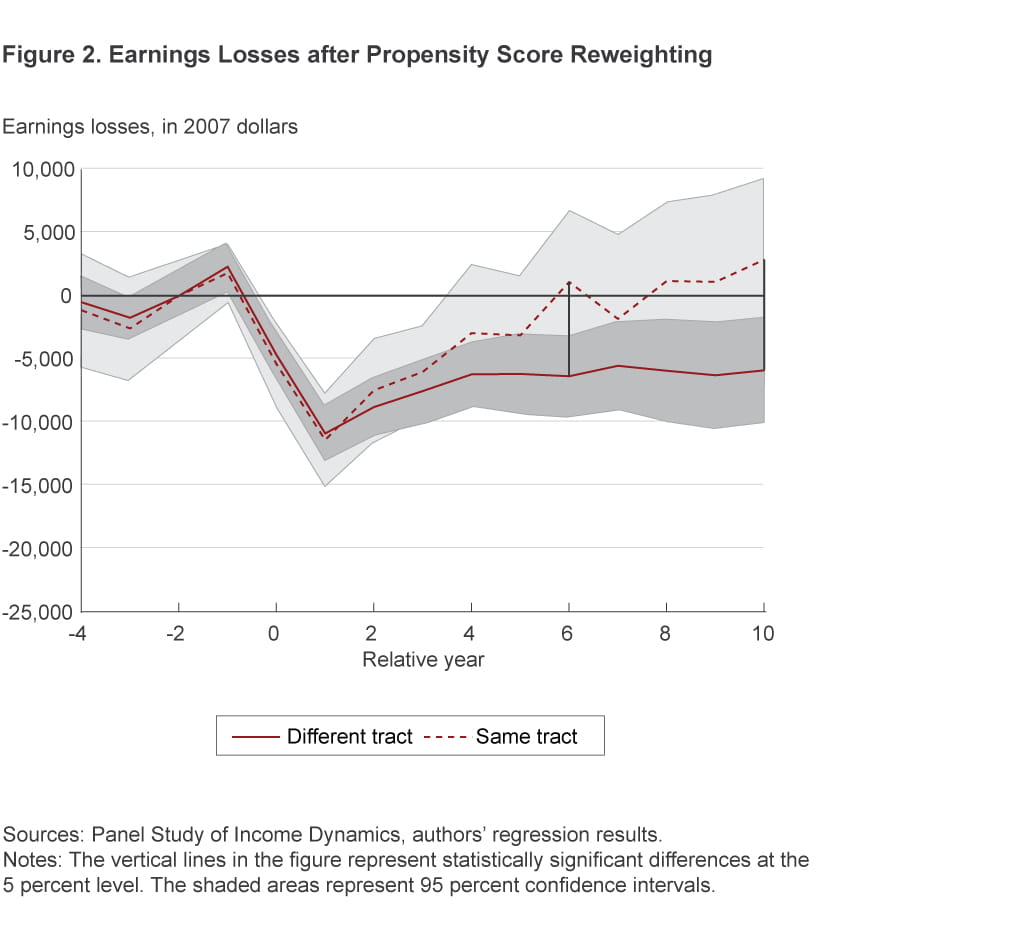
The most likely explanation for the better outcomes among workers who live close to their parents, then, seems actually to be the influence of parents and not something about the workers who choose to live close to their parents. We draw this conclusion for two important reasons. First, the propensity score method allows us to control for many characteristics of the workers and of the jobs that they lost. It is meaningful, then, that the effect survives even after these additional controls. Second, we suspect that any differences that remain after the reweighting will lead us to understate the true effect of parental proximity, since workers who have difficulty coping with changes should tend to remain closer to their parents.
Possible Mechanisms
Having established that the results in our previous Commentary (without propensity score reweighting) are likely causal, we are now in a position to study possible mechanisms for these results. Since the main results with and without propensity score reweighting are qualitatively similar, the following analysis, for simplicity, does not use propensity score reweighting.
We find that possible explanations for the postdisplacement earnings differences between individuals living in their parents’ neighborhoods and those living farther away are that displaced workers’ parents provide childcare and access to their employment networks. We find that an unlikely explanation is that displaced workers obtain any important savings on housing through their parents.
Figure 3 Panel A shows that for young displaced workers with children (red), the earnings trajectories around displacement look similar to the overall results for all displaced workers (blue). That is, if they are living in their parents’ neighborhoods prior to displacement, they see a strong earnings recovery, but if they are living farther away, they see large and permanent earnings losses. Panel B shows that for young workers who live in their parents’ neighborhoods and who do not have children (dashed red), the earnings recovery looks remarkably similar to that of those without children who live farther away from their parents (solid red). That is, for those without children, parental proximity does not matter. We interpret these findings as evidence that parents can help their adult children by stepping in to provide childcare after a job displacement.
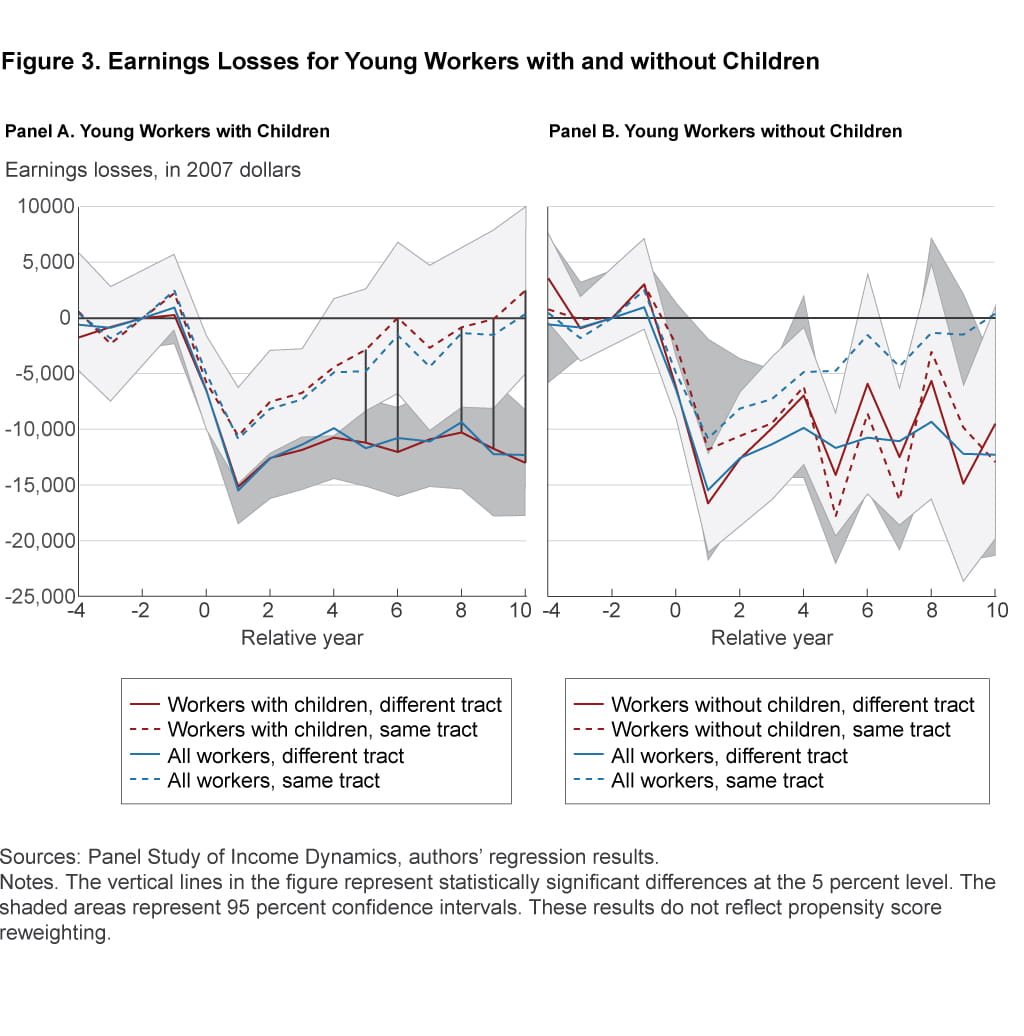
Figure 4 shows that those living in their parents’ neighborhoods are more likely to work in their parents’ industries after displacement than before, and those living farther away do not have this tendency. The effect is relatively large, with a 10 percentage point increase in working in a parent’s industry on a base of around 25 percent, though the estimates are noisy and we cannot statistically distinguish between the effects on the two groups. We think this is suggestive evidence, however, that employment networks may play an important role.
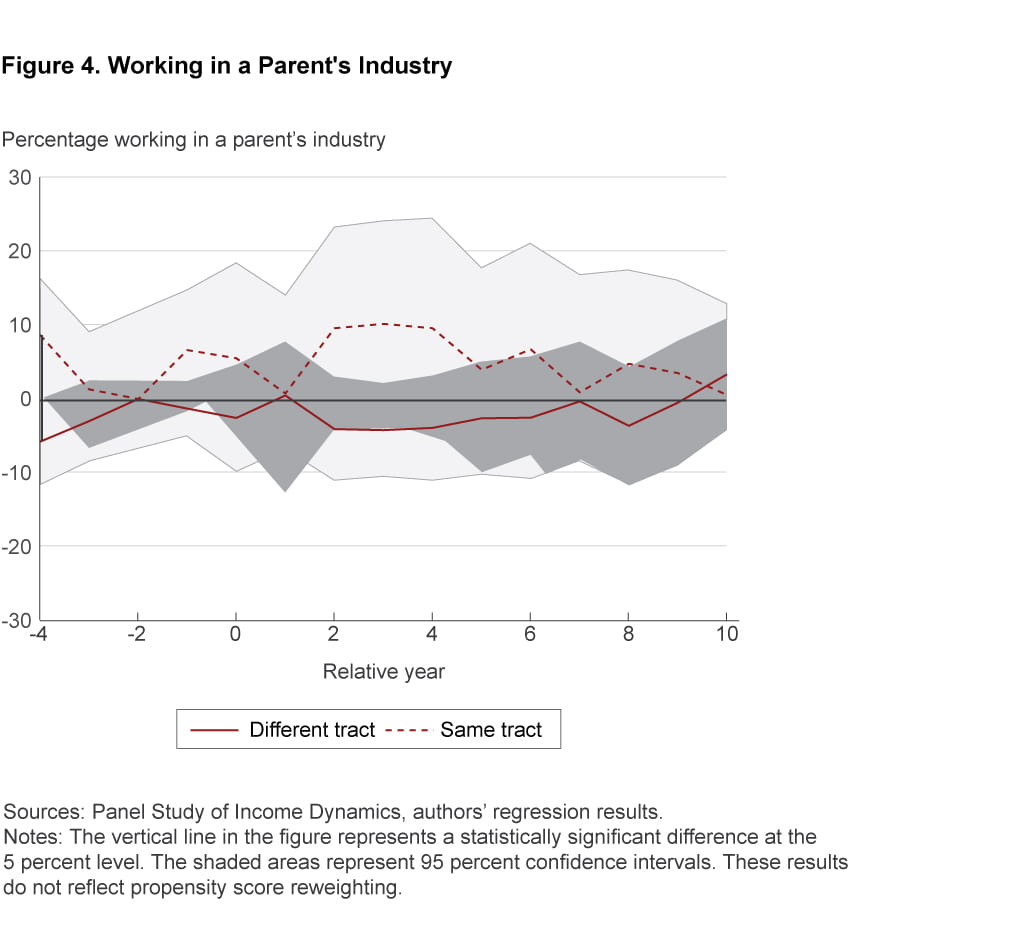
Some children move back in with their parents after a job displacement, but the savings on housing expenditures are quite small, suggesting that these savings are likely not responsible for large differences in earnings. Figure 5 shows this by plotting two measures of these housing savings around the time of a job loss. Panel A plots the proportion of workers receiving all of their rent as a gift from someone, and it shows a spike of around 4 percentage points around the time of job losses, for both people who live close to their parents and people who live farther away. Panel B shows the estimated dollar value of the housing savings by backing out how much workers seem to gain by living with another family (usually their parents). Around a displacement, the implied rent savings increase by about $150 per year for both those who live close to their parents and those who live farther away. There is no evidence that savings on housing increase more among people who lived closer to their parents before they lost their jobs. In fact, there is some suggestion that people who lived closer see housing savings decrease after a displacement. In any event, the savings on housing are small relative to the large declines in earnings and are unlikely to lead to the large differences in the postdisplacement earnings trajectories that we found.
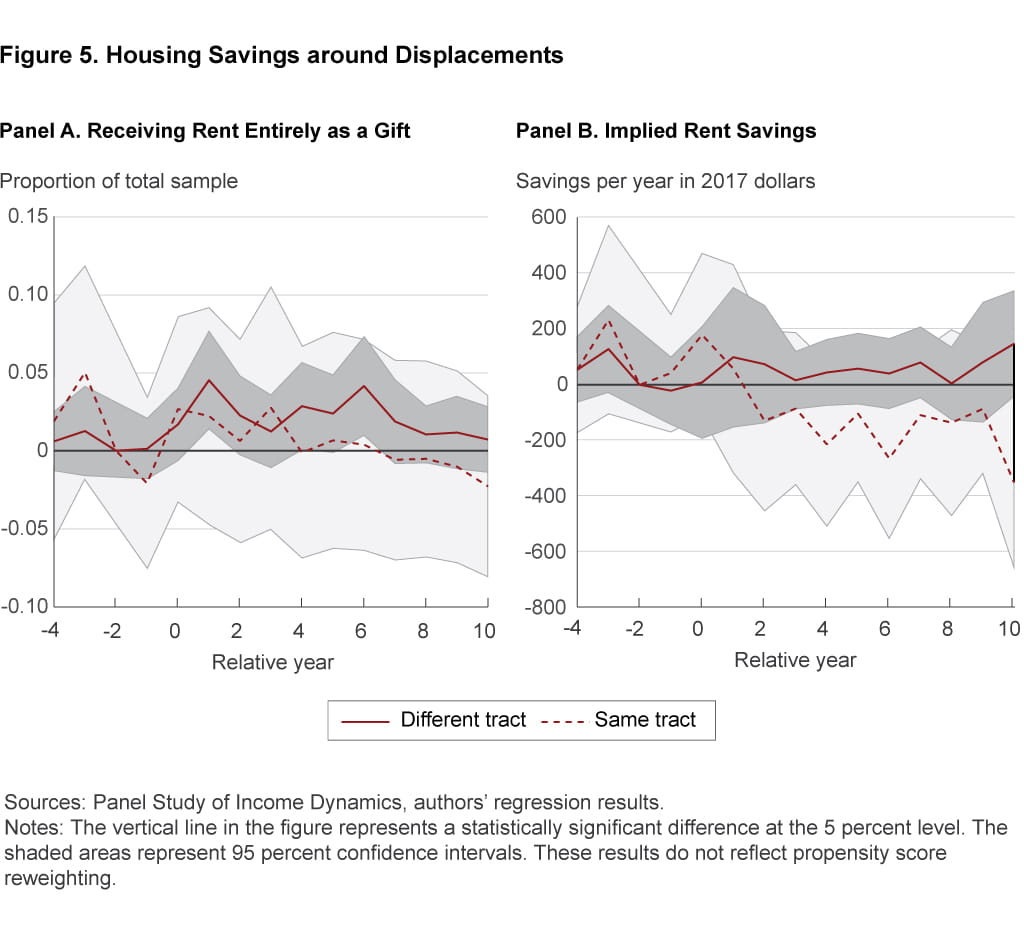
Policy Implications
Parents can improve the job prospects of their children who have lost jobs. We showed this by comparing workers who live in the same neighborhoods as their parents with a similar group of workers who live farther away. The workers who live close to their parents earn more after a job loss—so much so that the job loss does not appear to have any long-term effects on their earnings. While we cannot be sure what drives these differences, we do know that the effects are only apparent for workers who have children themselves and that workers are more likely to work in their parents’ industries after the job loss if they live in the same neighborhood as their parents.
If job networks and help with childcare are driving the earnings differences we find, policymakers may want to consider other ways to provide similar services. At the same time, providing these additional services involves costs and our analysis is insufficient to determine whether the benefits warrant the associated costs. Nevertheless, as an example of addressing job networks, many European countries have policies that combine unemployment insurance with a robust set of job services to help workers find suitable new jobs. To address issues with childcare, job seekers could be paired with flexible, subsidized childcare services that could support them through their job search into the first few months of new jobs.
Providing support for workers who live far from home, even if such support is an imperfect substitute for parental help, could encourage more workers to embrace distant job opportunities. Workers may receive the same services by living closer to their parents, but this lack of mobility can come at a significant cost in terms of lost earnings given that, on average, never-displaced workers who live near their parents earn far less than never-displaced workers who live farther away. Providing wider access to these services could actually make the workforce more agile in terms of where workers can live, and it could make people more able to adapt to declines in the places where they grew up.
Footnotes
- Krolikowski (2017) shows that these estimated earnings losses may be overstated somewhat, but finds that they are still substantial. Return
- We use census tracts to define “near,” and these tracts are typically thought of as neighborhoods. Return
- See, for example, http://www.pewsocialtrends.org/2012/03/15/the-boomerang-generation. Return
References
- Coate, Patrick, Pawel Krolikowski, and Mike Zabek. 2017a. “Parental Proximity and Earnings after Job Displacements.” Federal Reserve Bank of Cleveland, Working Paper, 17-22.
- Coate, Patrick, Pawel Krolikowski, and Mike Zabek. 2017b. “Parental Proximity and the Earnings Consequences of Job Loss.” Federal Reserve Bank of Cleveland, Economic Commentary, 2017-03.
- Jacobson, Louis S., Robert J. LaLonde, and Daniel G. Sullivan. 1993. “Earnings Losses of Displaced Workers.” American Economic Review, 83(4): 685–709.
- Krolikowski, Pawel. 2017. “Choosing a Control Group for Displaced Workers.” Federal Reserve Bank of Cleveland, Working Paper, 16-05R. Forthcoming in Industrial and Labor Relations Review.
Suggested Citation
Coate, Patrick, Pawel M. Krolikowski, and Mike Zabek. 2018. “Parental Assistance after Job Loss.” Federal Reserve Bank of Cleveland, Economic Commentary 2018-07. https://doi.org/10.26509/frbc-ec-201807
This work by Federal Reserve Bank of Cleveland is licensed under Creative Commons Attribution-NonCommercial 4.0 International





